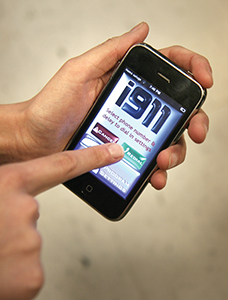
Alumni, students and staff at Binghamton University are designing iPhone applications to help create a safer and more convenient environment on campus. Their contributions to the app craze join the ranks of over 140,000 others available on the iTunes App Store.
i911
Alumni Jeffrey Midgley, class of ’04, and Adam Bitterman, class of ‘05 plan to bring the i911 app to all BU iPhone users.
The app is an emergency dialer, which the iPhone owner can program to call any number at the click of a button. The app, which is free to the general public through the App Store, can also call up to three police departments at once.
Midgley and Bitterman, co-founders of Jamb Innovations, got the idea for i911 upon realizing it took touching seven keys on the iPhone to call 911.
“It’s peace of mind wherever you go,” Midgley, a physician’s assistant, said.
Midgley and Bitterman, who worked for Harpur’s Ferry as BU students, have spoken with the ambulance service and with the Environmental Health and Safety Office to make i911 campus wide.
“We felt it would be a good way to give back and evolve the community where we started,” Midgley said.
ABC DATA
Nate Kruser, a technology coordinator at BU, is working with the Institute for Child Development to create iPhone apps in order to help children with development and learning disorders like autism. The applications are entry data collection systems that are able to record events and track the progress of students within their individualized curriculum.
In the past, a student’s progress was charted on paper or on a computer, but having multiple systems through this ABC Data app allows more room for error, Kruser said.
Kruser began developing the apps over a year ago. He was first working alone, but then his work caught the attention of Institute Director Raymond Romanczyk.
Collaborating with other programmers and clinicians, Kruser is working on developing a communication system for autistic children who have trouble communicating. The children will be able to tap on the screen at pictures and the device will speak for them, allowing helpful interaction.
“There is a tremendous need for communication systems for children with autism,” Romanczyk said. “Based on our experience in teaching communication and our long-time use of handheld devices, I am bringing together a group to design and implement an app to be used on the iTouch and iPhone.”
Romanczyk plans to develop the system and to distribute it to families with autistic children for free, replacing bulkier speech synthesizers that can cost up to $6,000 and be difficult to use.
“It is a complex project, but one that will have international implications for assisting children with autism,” he said.
PRE OPERATION EVALUATION
A BU student programmer has been working diligently to help physicians determine if a patient can be safely operated on.
Jonathan Alter, a senior majoring in computer science, has been managing all of the code development work for his iPhone app, Preop Eval, which uses an algorithm to calculate whether and in what time frame a patient can be operated on.
Alter noted that his app will benefit doctors.
“You need to have it at your fingertips. This program is there to fortify your knowledge,” said Alter, who is on the pre-medicine track and works as an Emergency Medical Technician with Harpur’s Ferry.
According to Alter, his product comes with a disclaimer that it should be used as a tool and not as an answer.
He is working with Eileen Head, director for the computer science undergraduate program; Leslie Lander, the graduate director; Madhusudhan Govindaraju, an associate professor of computer science and Dr. Joshua Steinberg of the SUNY Upstate Residency program, to create the application.
“The use of information technology via [iPhone] apps is a cost effective way to improve patient care,” Govindaraju said. “The idea is to provide physicians with a ready checklist, alerts, warnings and other information they might miss because of their busy schedules.”


